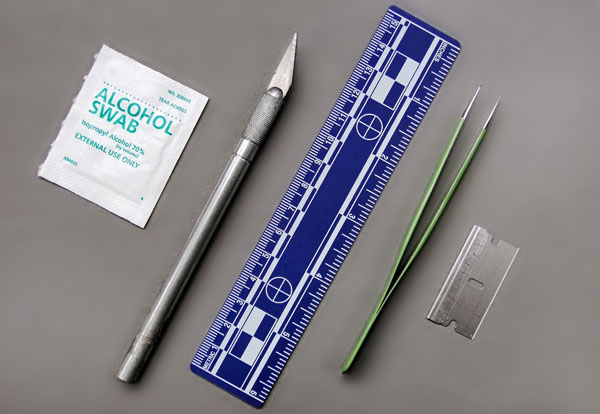Why and when is trace evidence used?
Every case potentially has trace evidence to consider, and investigators must use their knowledge, training and experience to thoroughly examine the scene, identifying and properly collecting the most probative evidence, including traces. This examination includes a focused search for and careful collection of anything that may yield clues or the potential for identifying key players.

Tiny fibers can be seen and collected using a variety of techniques such as alternate light sources. In this image, a tiny fiber fluoresces and is easily gathered from an article of clothing. (Courtesy of NFSTC)
An examination for trace evidence could happen at a crime scene, on victim’s or suspect’s clothing, or a location the victim or suspect may have been recently. For example, trace examiners may look for ligature fibers in the case of a strangling to identify what might have been used to commit the crime, or gunshot residue around a bullet hole to indicate the distance between a shooter and a victim. The body, clothing and jewelry of a crime victim are investigated for trace materials using the same precision methods as would be used at a crime scene.
In the investigation of a crime scene, investigators must prioritize what items will be collected and sent to the lab, and in what order it should be processed. Investigators using a holistic approach to the scene will gather evidence and prioritize each item by assessing its value based on the level of identification it may provide. Learn more about crime scene investigation ▸
Trace examiners use tools such as tweezers, tape, specialized vacuums, swabs, alternate light sources, and lasers to find and collect trace evidence. Following the principles of proper crime scene investigation, the collected materials are packaged, documented and sent to a crime laboratory for analysis.

Trace evidence collection tools. (Courtesy of NFSTC)
One of the most famous cases involving trace evidence was that of Wayne Williams, convicted of two counts of murder in 1982 in the infamous Atlanta Child Murders case. For a period of 22 months beginning in 1979, 30 black children and young men had disappeared or died under suspicious circumstances. Through the investigation, trace examiners found fibers and animal hairs that could not be excluded when looking for links between the cases. By identifying the fibers as carpeting, finding the manufacturer and computing probability statistics regarding the chance that they could have come from somewhere other than William’s home, investigators were able to begin to use this evidence to tie the victims to Williams. In doing the same with the animal hair in comparison with Williams’ dog, then calculating the statistics that someone would have a dog and carpeting that would be consistent with those of Williams made the case very strong and resulted in a conviction. In this example, trace evidence was the centerpiece of the prosecutor’s case and only careful evidence collection and examination made it possible.